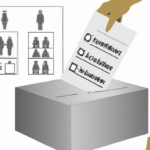There are various types of electoral systems used throughout the world to determine the outcomes of elections. One common system is the plurality system, where the candidate who receives the most votes wins, regardless of whether they have a majority. Another system is the majority system, where a candidate must obtain an absolute majority to win. Proportional representation systems allocate seats based on the percentage of votes received by each party, ensuring proportional representation in the legislative body. Mixed electoral systems combine elements of both plurality and proportional representation systems. Other electoral systems include the single transferable vote and the alternative vote, which prioritize voter preferences. Each system has its advantages and disadvantages, influencing the fairness and representativeness of elections.
1. First-Past-the-Post (FPTP): This is one of the simplest types of electoral systems commonly used around the world. In FPTP, voters cast their vote for a single candidate, and the candidate with the most votes wins the election, regardless of the percentage of votes they receive. This system tends to favor larger political parties and can result in a disproportionate representation of parties in the legislature.
2. Proportional Representation (PR): PR aims to provide a more accurate representation of voters’ preferences in the legislature. Parties are awarded seats in proportion to the percentage of votes they receive. There are various methods within PR systems, such as List PR, Single Transferable Vote (STV), and Mixed Member Proportional (MMP).
3. List PR: In this system, voters vote for a political party rather than individual candidates. Parties compile a list of candidates, and seats in the legislature are allocated based on the proportion of votes received by each party. Seats are filled by candidates from the party list in the order determined by the party.
4. Single Transferable Vote (STV): STV allows voters to rank their preferred candidates on the ballot. Candidates are elected based on a specific quota in each constituency. If a candidate exceeds the quota, surplus votes are transferred to other candidates according to voters’ subsequent preferences. This transfer process continues until all seats are filled.
5. Mixed Member Proportional (MMP): MMP is a combination of FPTP and List PR. Voters cast two votes: one for a single candidate in their constituency (FPTP), and another for a political party (List PR). Some seats are allocated based on FPTP results, while others are assigned to ensure proportionality through the party list.
6. Majoritarian Systems: Majoritarian systems, such as two-round systems and alternative vote (AV), aim to ensure that winners have majority support. In two-round systems, if no candidate receives an absolute majority in the first round, a second round between the top candidates is held. AV allows voters to rank candidates, and the candidate with the most first-preference votes wins. If no candidate reaches a majority in AV, lower-ranked preferences are redistributed.
7. Single Non-transferable Vote (SNTV): SNTV is used in multi-member constituencies, where voters cast a single vote for a candidate. The candidates with the most votes are elected. This system tends to favor larger parties and can result in skewed representation.
These are just a few examples of the various types of electoral systems used worldwide, each with its own merits and drawbacks. The choice of electoral system can have a significant impact on representation and the functioning of democracy.
Pros and cons of proportional representation
Proportional representation (PR) is an electoral system that aims to provide fair representation to political parties or groups in proportion to the votes they receive from the electorate. Like any other electoral system, PR has its advantages and disadvantages.
Pros:
1. Reflects voter preferences: PR ensures that the composition of a legislative body closely mirrors the choices made by the electorate. It enables smaller or minority parties to secure representation, giving a voice to a diverse range of political views.
2. Promotes inclusivity: PR tends to foster inclusiveness by encouraging political parties to represent a wider range of social, cultural, and economic interests. This can lead to greater minority representation, gender balance, and representation for marginalized groups.
3. Enhances political stability: By offering a fair representation to different parties, PR systems often lead to more stable governments. Coalition governments, which frequently emerge under PR, encourage cooperation and compromise, reducing the chances of extremist or radical policies being implemented.
4. Encourages voter participation: PR offers voters a greater sense of influence over the political process and a higher chance that their vote will translate into representation. As a result, it can boost voter confidence and increase voter turnout.
Cons:
1. Potential for political fragmentation: Proportional representation can result in a larger number of smaller parties, which may complicate the formation of stable governments. Coalition-building often becomes necessary, and the resulting governments may struggle to implement policies efficiently.
2. Weaker accountability: PR systems tend to weaken the direct connection between constituents and their elected representatives. With multiple MPs representing a district, there is often less direct accountability to individual voters, making it harder for citizens to voice their concerns or hold their representatives accountable.
3. Slow decision-making process: The negotiation and compromise required in coalition governments can lead to slower decision-making. Consensus-building among multiple parties may be time-consuming, making it more challenging to react swiftly to urgent matters.
4. Dominance of the party list: In PR systems that rely heavily on closed party lists, party leadership can exert significant control over the list of candidates. This can limit the influence of individual voters in determining who represents them and may reduce the diversity within political parties.
In summary, proportional representation has the potential to provide more inclusive representation, foster political stability and increase voter participation. However, it can also lead to fragmentation, weaker accountability, slower decision-making, and potential dominance of party leadership over candidate selection. Understanding these pros and cons is crucial when considering the implementation of proportional representation as an electoral system.
Advantages and disadvantages of first-past-the-post system
Advantages:
1. Simplicity: One of the main advantages of the first-past-the-post (FPTP) electoral system is its simplicity. It is easy to understand and implement, making it accessible for both voters and election organizers. This simplicity helps ensure a smooth functioning of the electoral process.
2. Strong and Stable Governments: FPTP tends to produce majority governments, where a single party or coalition has a clear majority of seats in the legislature. This allows for decisive decision-making and strong, stable governments that can act quickly and efficiently.
3. Reflects Local Representation: FPTP systems emphasize local representation, as each constituency elects a single representative. This ensures that constituents have a direct link to their elected representative, giving them a voice in their specific area.
4. Encourages Broad-Based Parties: FPTP can encourage parties to appeal to a broad range of voters, as they need to secure a plurality of votes in each constituency. This helps foster parties that aim to be inclusive and address the concerns of a wide range of voters.
Disadvantages:
1. Winner-takes-all: FPTP is known for its winner-takes-all characteristic, where the candidate with the most votes in a constituency wins, even if they don’t have an absolute majority. This can lead to a lack of representation for minority views or parties, as their votes may be spread out across different constituencies without actually winning any seats.
2. Wasted Votes: In FPTP, votes for losing candidates are wasted, as they have no impact on the final outcome. This can lead to a discouragement of voter turnout, as some individuals might feel their vote doesn’t matter if they support a less popular candidate or party.
3. Lack of Proportional Representation: FPTP often leads to distorted outcomes, with parties receiving a different share of seats in the legislature compared to their share of the popular vote. This can result in a discrepancy between the vote share a party receives nationally and the number of seats they secure, leading to a perceived lack of fairness in the system.
4. Limited Choice: FPTP limits voter choice, as it tends to reinforce a two-party system or favor large, established parties. Smaller parties may struggle to gain representation, as they find it difficult to secure a plurality of votes in any given constituency. This can limit political diversity and potentially stifle alternative viewpoints.
In conclusion, the first-past-the-post electoral system offers advantages such as simplicity, local representation, and the ability to deliver strong and stable governments. However, it also presents disadvantages such as winner-takes-all dynamics, wasted votes, a lack of proportional representation, and limited voter choice. Understanding and evaluating these advantages and disadvantages is crucial when considering the effectiveness and fairness of the FPTP system.
Characteristics of preferential voting
Characteristics of preferential voting refer to the specific attributes and features inherent in this electoral system. Preferential voting, also known as ranked-choice voting or instant-runoff voting, presents several characteristics that distinguish it from other electoral systems. Here are some key features of preferential voting:
1. Ranking Candidates: Preferential voting allows voters to rank candidates in order of preference. Instead of selecting a single candidate, voters have the opportunity to express their preferences by ranking all candidates on the ballot. This ranking system ensures a more accurate representation of voters’ preferences and reduces the likelihood of wasted votes.
2. Elimination Rounds: Another crucial characteristic of preferential voting is the implementation of elimination rounds. After the initial count, the candidate with the fewest first-preference votes is eliminated. Their votes are then distributed among the remaining candidates based on the voters’ subsequent preferences. This process continues until one candidate gains an outright majority of votes.
3. Majority Decision: Preferential voting aims to elect a candidate who secures a majority, rather than a mere plurality. This means that to win, a candidate must receive more than 50% of the votes. Through the redistribution of lower-ranked candidates’ votes, the system ensures that the winning candidate is the one preferred by the majority of voters.
4. Broad Representation: The preferential voting system holds the potential to provide a more diverse and representative outcome. By allowing voters to rank candidates, it gives voice to individuals who support smaller or niche parties or independent candidates. This promotes a more inclusive political landscape and encourages a wider range of perspectives to be heard and represented.
5. Reducing Tactical Voting: Preferential voting discourages tactical voting, as voters have the opportunity to express their true preferences without worrying about splitting the vote or wasting their ballot. Voters can rank their favorite candidate higher without fear of inadvertently helping a less-preferred candidate to win.
6. Runoff and Consensus Building: As the name “instant-runoff voting” suggests, preferential voting eliminates the need for separate runoff elections. By allowing voters to rank candidates, the system identifies the candidate with the broadest appeal from the beginning. This promotes efficiency in the election process and encourages greater consensus-building among candidates and their supporters.
These are some of the main characteristics of preferential voting. By allowing voters to express their preferences more accurately, promoting majority decision-making, and encouraging diverse representation, this electoral system offers a range of benefits. It remains a popular option in many countries due to its ability to reduce polarization and produce outcomes that better reflect the will of the electorate.
Features of mixed-member proportional representation
Mixed-member proportional representation (MMP) is an electoral system that combines aspects of both proportional representation and single-member constituency systems. It aims to provide a balance between the benefits of both systems, ensuring a fair and representative outcome.
One of the key features of MMP is the use of two types of representatives: constituency representatives and party list representatives. Under this system, voters have two votes – one for their preferred constituency candidate and one for a political party.
The first feature of MMP is the allocation of seats in two different ways. The constituency representatives are elected through the first-past-the-post system, where the candidate with the highest number of votes in a specific geographic area wins a seat in parliament. This ensures that there is a direct link between constituents and their representatives.
The second type of representatives, party list representatives, are allocated based on the proportion of votes each party receives. This is achieved through a process known as the “top-up” mechanism. Parties submit a list of candidates in a ranked order, and the number of party list seats they receive is determined by the overall share of the vote they receive. This allows for greater proportionality and representation of smaller parties.
Another feature of MMP is the use of compensation seats. These seats are introduced to address any imbalances resulting from the allocation of constituency seats. If a party wins more constituency seats than its overall share of the vote would suggest, it is allocated additional party list seats to ensure a fair representation of overall support.
MMP also encourages a two-level form of representation. Constituency representatives are accountable to their specific geographic area, while party list representatives are responsible for representing the interests of the party and its supporters. This dual representation ensures that both local concerns and broader national interests are taken into consideration.
Furthermore, MMP promotes inclusivity and diversity in representation. With the use of party lists, parties are able to include candidates from underrepresented groups, such as women and ethnic minorities, thereby increasing their chances of being elected. This feature allows for a more representative and diverse parliament.
In summary, the features of mixed-member proportional representation include the allocation of seats through both first-past-the-post and party list systems, the use of compensation seats to ensure proportionality, a two-level form of representation, and the promotion of inclusivity and diversity. By combining aspects of both proportional representation and single-member constituency systems, MMP strives to achieve a more fair and representative electoral outcome.
Impact of electronic voting systems.
Electronic voting systems have gained significant popularity in recent years due to their potential impact on the electoral process. These systems utilize technology to streamline and modernize voting procedures, replacing traditional paper-based methods. The impact of electronic voting systems can be examined from various perspectives, including efficiency, accessibility, security, and voter confidence.
One of the primary benefits of electronic voting systems is the efficiency they bring to the electoral process. These systems eliminate the need for manual vote counting, which can be time-consuming and error-prone. With electronic systems, results can be tallied quickly and accurately, reducing the chances of human error or potential manipulation. This efficiency provides faster election results, allowing for prompt decision-making and reducing the uncertainty associated with waiting for manual counting.
Another significant impact of electronic voting systems is increased accessibility. These systems often incorporate features to assist voters with disabilities, such as audio guides or tactile interfaces, enabling them to cast their votes independently. Electronic systems can also provide language translation options, ensuring that non-native speakers can participate fully in the electoral process. By removing barriers to voting, electronic systems promote inclusivity and democratic participation.
One crucial aspect to consider when analyzing the impact of electronic voting systems is security. While electronic systems offer the potential for heightened security measures, there is also the risk of cyber threats and hacking attempts. To mitigate these risks, robust security protocols must be implemented, including encryption, firewalls, and regular system updates. Additionally, comprehensive auditing and monitoring processes should be in place to ensure the integrity and transparency of the voting system. Incorporating strong security measures is vital to maintaining voter trust and confidence in the electronic voting process.
On the subject of voter confidence, electronic voting systems have the potential to enhance trust in the electoral process. By minimizing human error and increasing transparency, these systems can alleviate concerns about fraudulent activities and discrepancies. Electronic systems also provide greater opportunities for verifying and auditing results, as electronic records can be easily accessed and reviewed. By promoting accuracy and accountability, electronic voting systems help build trust and increase confidence in the democratic process.
While electronic voting systems offer numerous advantages, it is important to acknowledge the challenges they present. Implementation costs, technological infrastructure requirements, and the need for continuous updates and maintenance are factors that need consideration. Additionally, concerns about voter privacy and the possibility of system malfunctions must be addressed to ensure the smooth functioning of electronic voting systems.
In conclusion, the impact of electronic voting systems on electoral processes is substantial. Their efficiency, accessibility, security, and potential to increase voter confidence make them an attractive option for modernizing elections. However, careful planning, investment in security measures, and continuous evaluation are necessary to ensure the successful and credible implementation of electronic voting systems.













